Liangyu Xu
GeoSense: Evaluating Identification and Application of Geometric Principles in Multimodal Reasoning
Apr 17, 2025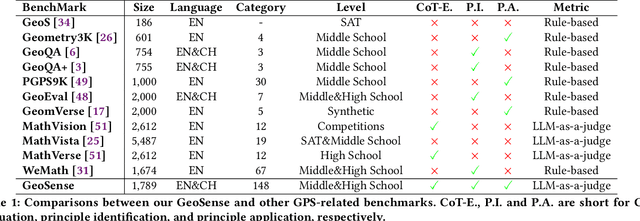
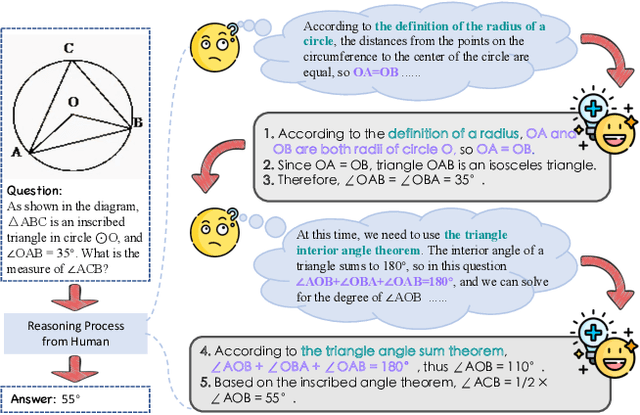
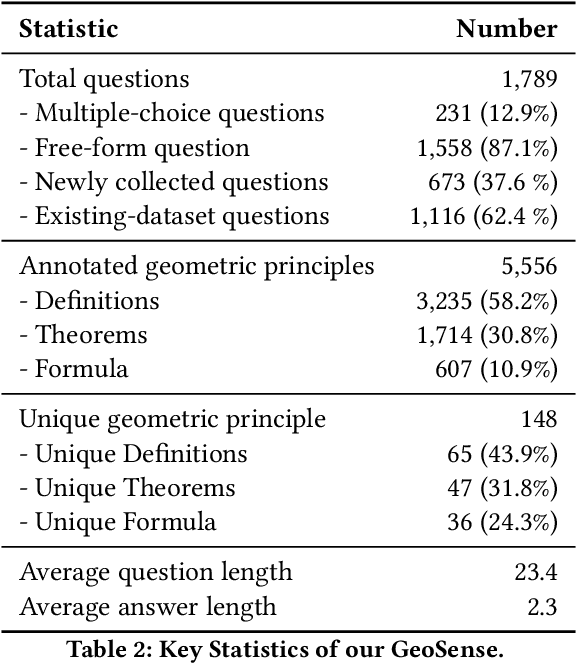
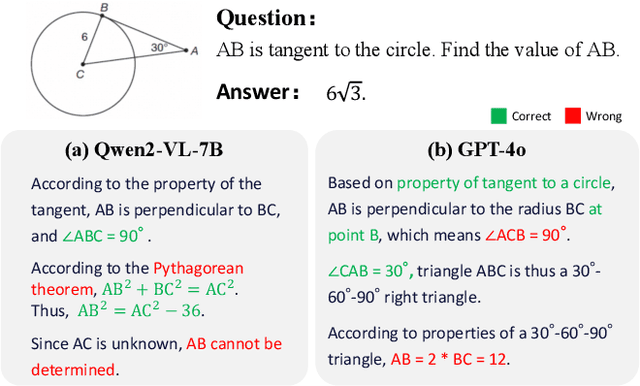
Abstract:Geometry problem-solving (GPS), a challenging task requiring both visual comprehension and symbolic reasoning, effectively measures the reasoning capabilities of multimodal large language models (MLLMs). Humans exhibit strong reasoning ability in this task through accurate identification and adaptive application of geometric principles within visual contexts. However, existing benchmarks fail to jointly assess both dimensions of the human-like geometric reasoning mechanism in MLLMs, remaining a critical gap in assessing their ability to tackle GPS. To this end, we introduce GeoSense, the first comprehensive bilingual benchmark designed to systematically evaluate the geometric reasoning abilities of MLLMs through the lens of geometric principles. GeoSense features a five-level hierarchical framework of geometric principles spanning plane and solid geometry, an intricately annotated dataset of 1,789 problems, and an innovative evaluation strategy. Through extensive experiments on GeoSense with various open-source and closed-source MLLMs, we observe that Gemini-2.0-pro-flash performs best, achieving an overall score of $65.3$. Our in-depth analysis reveals that the identification and application of geometric principles remain a bottleneck for leading MLLMs, jointly hindering their reasoning abilities. These findings underscore GeoSense's potential to guide future advancements in MLLMs' geometric reasoning capabilities, paving the way for more robust and human-like reasoning in artificial intelligence.
FRAMES: Boosting LLMs with A Four-Quadrant Multi-Stage Pretraining Strategy
Feb 08, 2025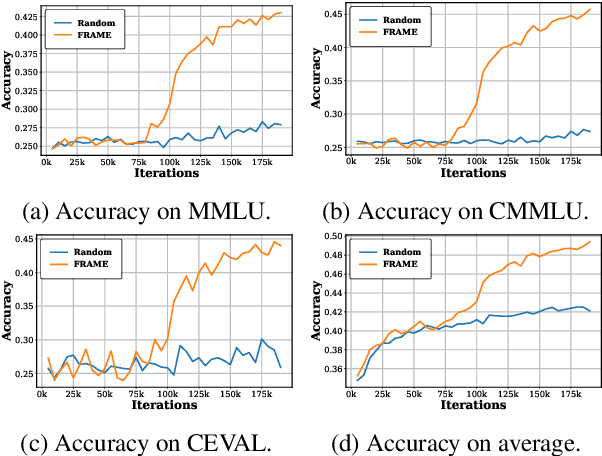
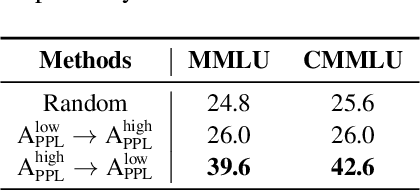
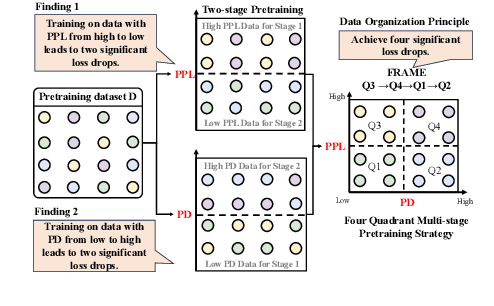
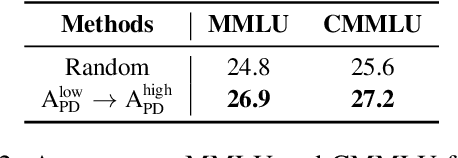
Abstract:Large language models (LLMs) have significantly advanced human language understanding and generation, with pretraining data quality and organization being crucial to their performance. Multi-stage pretraining is a promising approach, but existing methods often lack quantitative criteria for data partitioning and instead rely on intuitive heuristics. In this paper, we propose the novel Four-quadRAnt Multi-stage prEtraining Strategy (FRAMES), guided by the established principle of organizing the pretraining process into four stages to achieve significant loss reductions four times. This principle is grounded in two key findings: first, training on high Perplexity (PPL) data followed by low PPL data, and second, training on low PPL difference (PD) data followed by high PD data, both causing the loss to drop significantly twice and performance enhancements. By partitioning data into four quadrants and strategically organizing them, FRAMES achieves a remarkable 16.8% average improvement over random sampling across MMLU and CMMLU, effectively boosting LLM performance.
FIRE: Flexible Integration of Data Quality Ratings for Effective Pre-Training
Feb 02, 2025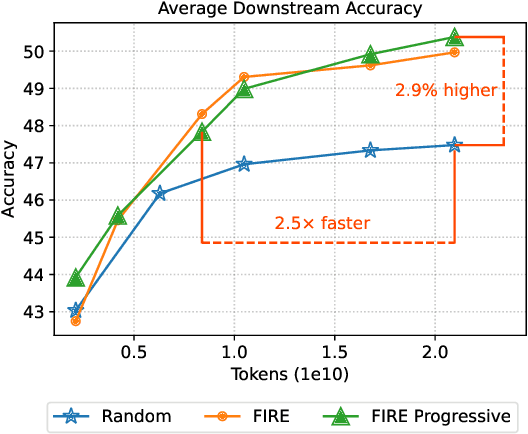
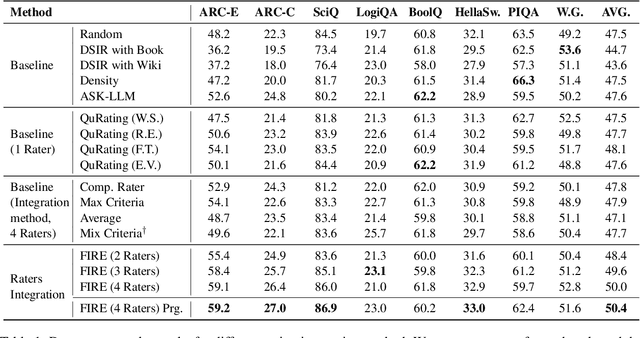
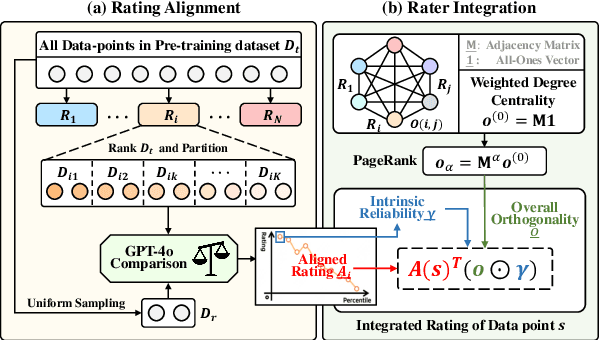

Abstract:Selecting high-quality data can significantly improve the pre-training efficiency of large language models (LLMs). Existing methods often rely on heuristic techniques and single quality signals, limiting their ability to comprehensively evaluate data quality. In this work, we propose FIRE, a flexible and scalable framework for integrating multiple data quality raters, which allows for a comprehensive assessment of data quality across various dimensions. FIRE aligns multiple quality signals into a unified space, and integrates diverse data quality raters to provide a comprehensive quality signal for each data point. Further, we introduce a progressive data selection scheme based on FIRE that iteratively refines the selection of high-quality data points, balancing computational complexity with the refinement of orthogonality. Experiments on the SlimPajama dataset reveal that FIRE consistently outperforms other selection methods and significantly enhances the pre-trained model across a wide range of downstream tasks, with a 2.9\% average performance boost and reducing the FLOPs necessary to achieve a certain performance level by more than half.
Corner2Net: Detecting Objects as Cascade Corners
Nov 24, 2024



Abstract:The corner-based detection paradigm enjoys the potential to produce high-quality boxes. But the development is constrained by three factors: 1) Hard to match corners. Heuristic corner matching algorithms can lead to incorrect boxes, especially when similar-looking objects co-occur. 2) Poor instance context. Two separate corners preserve few instance semantics, so it is difficult to guarantee getting both two class-specific corners on the same heatmap channel. 3) Unfriendly backbone. The training cost of the hourglass network is high. Accordingly, we build a novel corner-based framework, named Corner2Net. To achieve the corner-matching-free manner, we devise the cascade corner pipeline which progressively predicts the associated corner pair in two steps instead of synchronously searching two independent corners via parallel heads. Corner2Net decouples corner localization and object classification. Both two corners are class-agnostic and the instance-specific bottom-right corner further simplifies its search space. Meanwhile, RoI features with rich semantics are extracted for classification. Popular backbones (e.g., ResNeXt) can be easily connected to Corner2Net. Experimental results on COCO show Corner2Net surpasses all existing corner-based detectors by a large margin in accuracy and speed.
* This paper is accepted by 27th EUROPEAN CONFERENCE ON ARTIFICIAL INTELLIGENCE (ECAI 2024)
SDL-MVS: View Space and Depth Deformable Learning Paradigm for Multi-View Stereo Reconstruction in Remote Sensing
May 27, 2024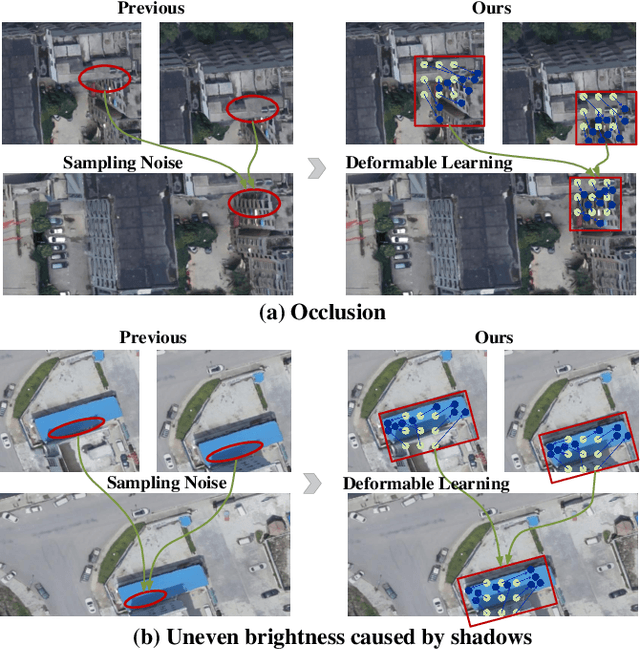
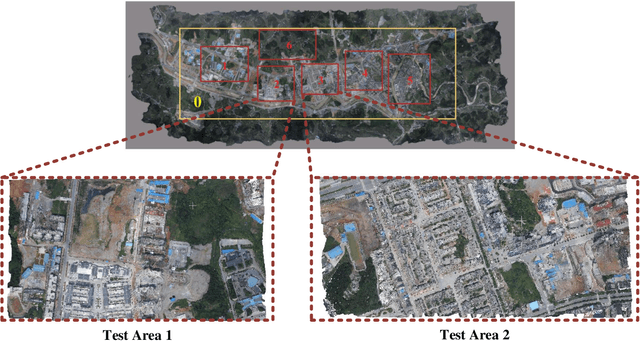
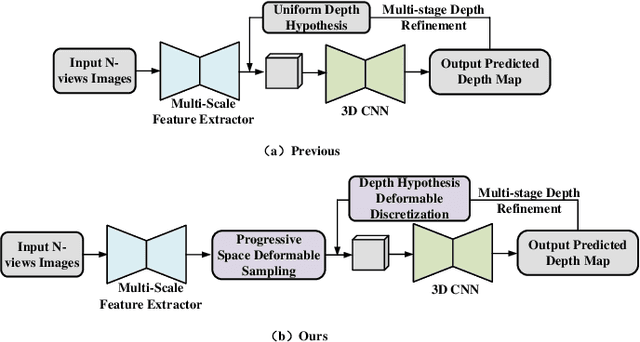
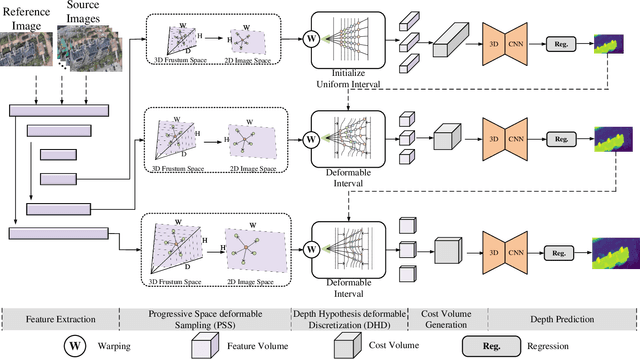
Abstract:Research on multi-view stereo based on remote sensing images has promoted the development of large-scale urban 3D reconstruction. However, remote sensing multi-view image data suffers from the problems of occlusion and uneven brightness between views during acquisition, which leads to the problem of blurred details in depth estimation. To solve the above problem, we re-examine the deformable learning method in the Multi-View Stereo task and propose a novel paradigm based on view Space and Depth deformable Learning (SDL-MVS), aiming to learn deformable interactions of features in different view spaces and deformably model the depth ranges and intervals to enable high accurate depth estimation. Specifically, to solve the problem of view noise caused by occlusion and uneven brightness, we propose a Progressive Space deformable Sampling (PSS) mechanism, which performs deformable learning of sampling points in the 3D frustum space and the 2D image space in a progressive manner to embed source features to the reference feature adaptively. To further optimize the depth, we introduce Depth Hypothesis deformable Discretization (DHD), which achieves precise positioning of the depth prior by adaptively adjusting the depth range hypothesis and performing deformable discretization of the depth interval hypothesis. Finally, our SDL-MVS achieves explicit modeling of occlusion and uneven brightness faced in multi-view stereo through the deformable learning paradigm of view space and depth, achieving accurate multi-view depth estimation. Extensive experiments on LuoJia-MVS and WHU datasets show that our SDL-MVS reaches state-of-the-art performance. It is worth noting that our SDL-MVS achieves an MAE error of 0.086, an accuracy of 98.9% for <0.6m, and 98.9% for <3-interval on the LuoJia-MVS dataset under the premise of three views as input.
TAFormer: A Unified Target-Aware Transformer for Video and Motion Joint Prediction in Aerial Scenes
Mar 27, 2024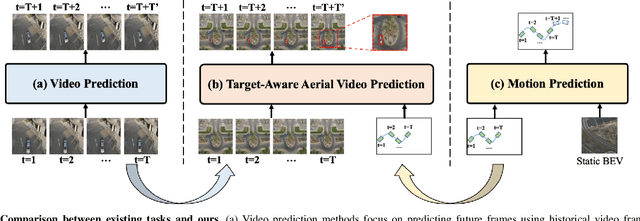
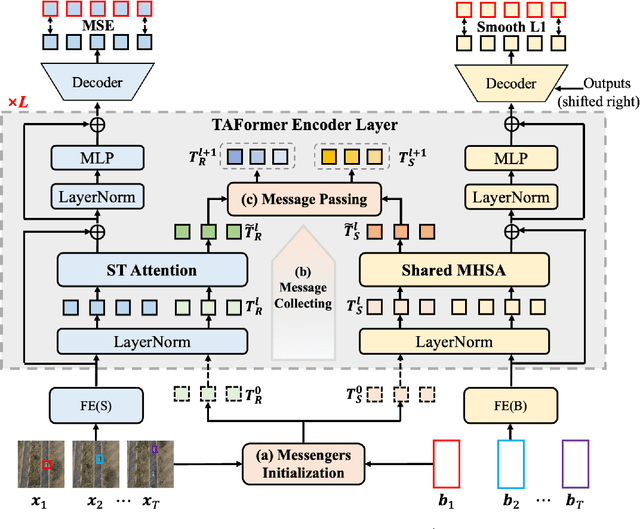
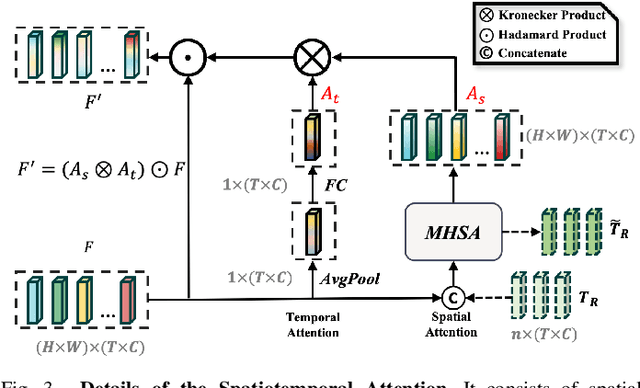
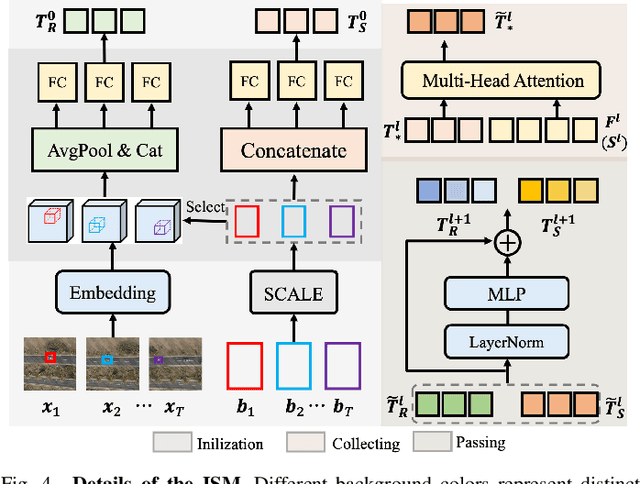
Abstract:As drone technology advances, using unmanned aerial vehicles for aerial surveys has become the dominant trend in modern low-altitude remote sensing. The surge in aerial video data necessitates accurate prediction for future scenarios and motion states of the interested target, particularly in applications like traffic management and disaster response. Existing video prediction methods focus solely on predicting future scenes (video frames), suffering from the neglect of explicitly modeling target's motion states, which is crucial for aerial video interpretation. To address this issue, we introduce a novel task called Target-Aware Aerial Video Prediction, aiming to simultaneously predict future scenes and motion states of the target. Further, we design a model specifically for this task, named TAFormer, which provides a unified modeling approach for both video and target motion states. Specifically, we introduce Spatiotemporal Attention (STA), which decouples the learning of video dynamics into spatial static attention and temporal dynamic attention, effectively modeling the scene appearance and motion. Additionally, we design an Information Sharing Mechanism (ISM), which elegantly unifies the modeling of video and target motion by facilitating information interaction through two sets of messenger tokens. Moreover, to alleviate the difficulty of distinguishing targets in blurry predictions, we introduce Target-Sensitive Gaussian Loss (TSGL), enhancing the model's sensitivity to both target's position and content. Extensive experiments on UAV123VP and VisDroneVP (derived from single-object tracking datasets) demonstrate the exceptional performance of TAFormer in target-aware video prediction, showcasing its adaptability to the additional requirements of aerial video interpretation for target awareness.
SFTformer: A Spatial-Frequency-Temporal Correlation-Decoupling Transformer for Radar Echo Extrapolation
Feb 28, 2024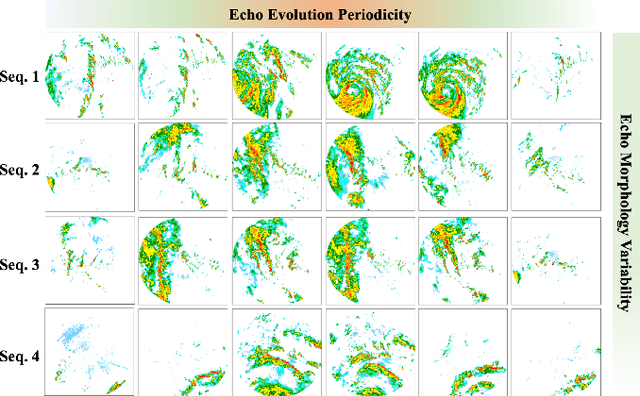
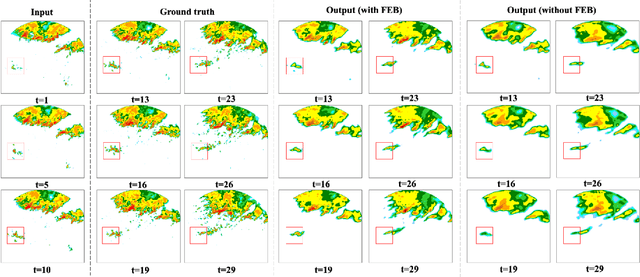
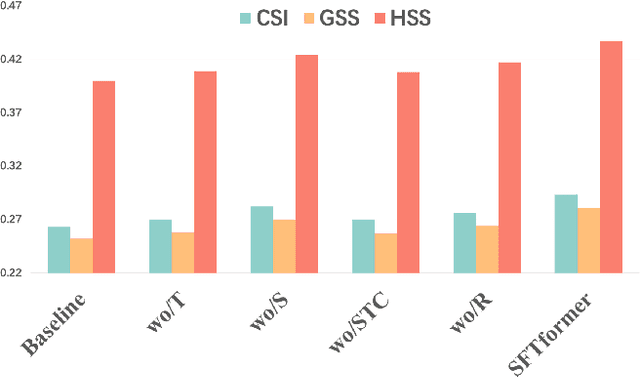
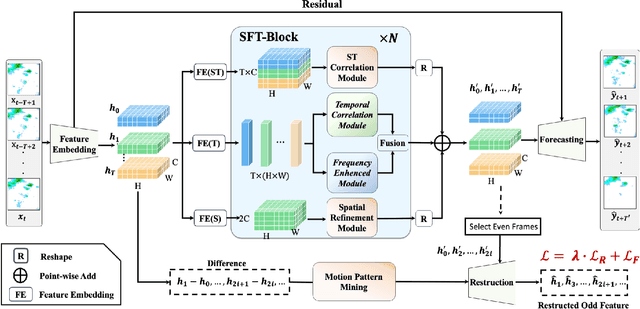
Abstract:Extrapolating future weather radar echoes from past observations is a complex task vital for precipitation nowcasting. The spatial morphology and temporal evolution of radar echoes exhibit a certain degree of correlation, yet they also possess independent characteristics. {Existing methods learn unified spatial and temporal representations in a highly coupled feature space, emphasizing the correlation between spatial and temporal features but neglecting the explicit modeling of their independent characteristics, which may result in mutual interference between them.} To effectively model the spatiotemporal dynamics of radar echoes, we propose a Spatial-Frequency-Temporal correlation-decoupling Transformer (SFTformer). The model leverages stacked multiple SFT-Blocks to not only mine the correlation of the spatiotemporal dynamics of echo cells but also avoid the mutual interference between the temporal modeling and the spatial morphology refinement by decoupling them. Furthermore, inspired by the practice that weather forecast experts effectively review historical echo evolution to make accurate predictions, SFTfomer incorporates a joint training paradigm for historical echo sequence reconstruction and future echo sequence prediction. Experimental results on the HKO-7 dataset and ChinaNorth-2021 dataset demonstrate the superior performance of SFTfomer in short(1h), mid(2h), and long-term(3h) precipitation nowcasting.
 Add to Chrome
Add to Chrome Add to Firefox
Add to Firefox Add to Edge
Add to Edge